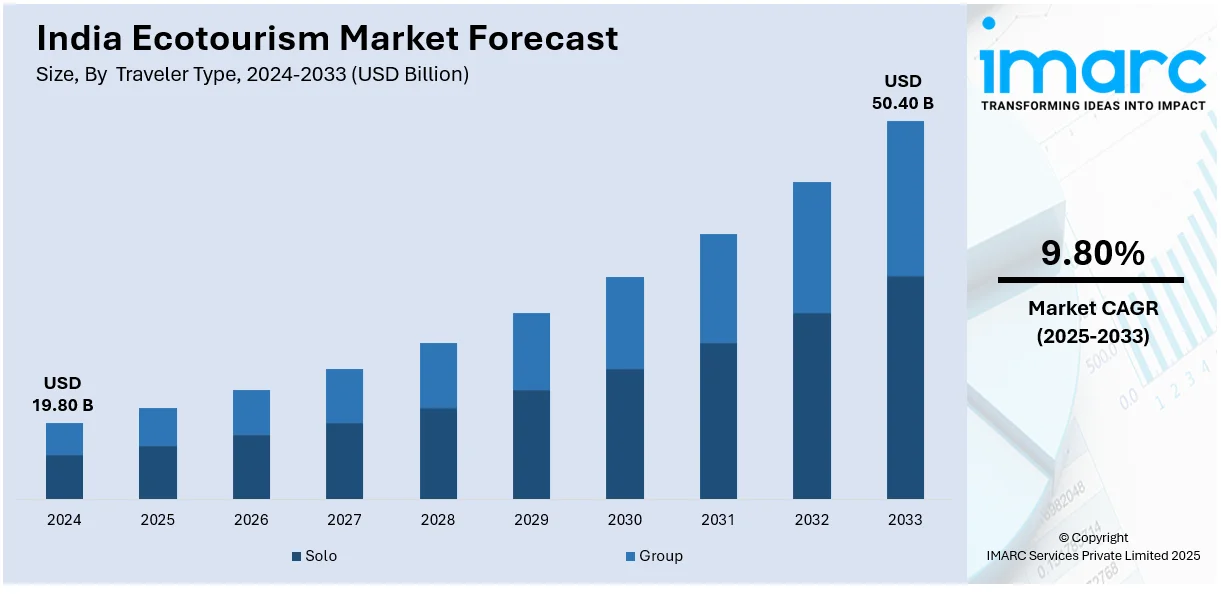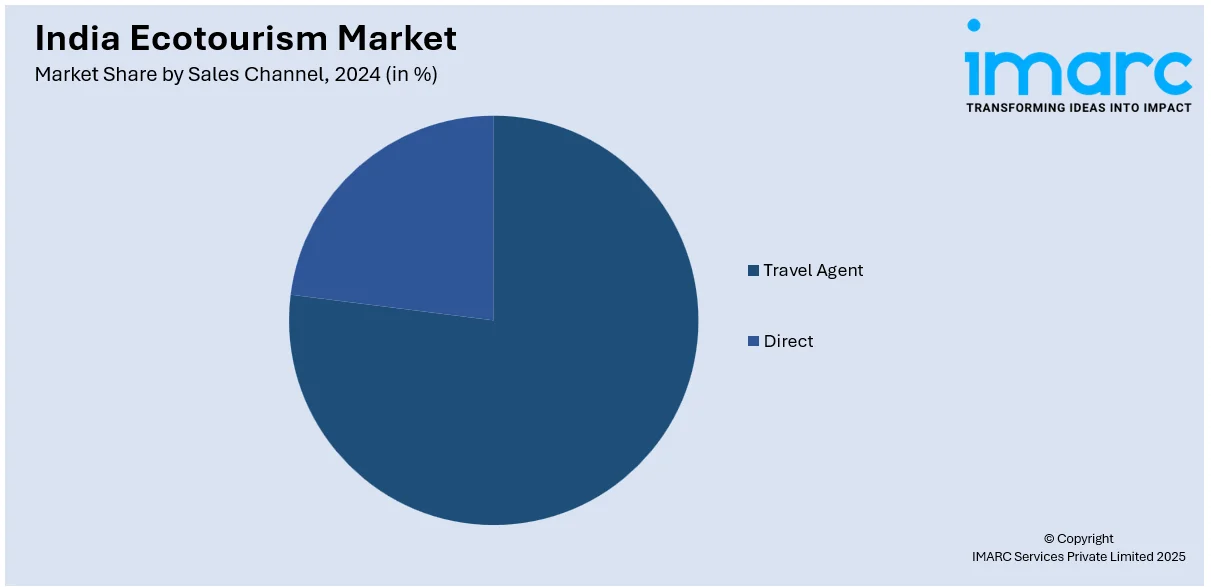
India Ecotourism Market Size, Share, Trends and Forecast by Traveler Type, Age Group, Sales Channel, and Region, 2025-2033
India Ecotourism Market Overview:
The India ecotourism market size reached USD 19.80 Billion in 2024. Looking forward, IMARC Group expects the market to reach USD 50.40 Billion by 2033, exhibiting a growth rate (CAGR) of 9.80% during 2025-2033. Growing environmental awareness, government initiatives promoting sustainable tourism, rising demand for nature-based travel experiences, increasing disposable income, expansion of eco-friendly accommodations, corporate interest in green travel, and enhanced connectivity to remote destinations are expanding the India ecotourism market share.
|
Report Attribute
|
Key Statistics
|
|---|---|
|
Base Year
|
2024 |
|
Forecast Years
|
2025-2033
|
|
Historical Years
|
2019-2024
|
| Market Size in 2024 | USD 19.80 Billion |
| Market Forecast in 2033 | USD 50.40 Billion |
| Market Growth Rate 2025-2033 | 9.80% |
India Ecotourism Market Trends:
Rising Consumer Awareness and Sustainable Travel Preferences
The increasing awareness regarding environmental conservation and sustainable travel is driving the India ecotourism market growth. For instance, according to a recent survey, which was released on March 19, 2025, 82% of Indian tourists place a high priority on sustainability when planning their trips in 2025, making India the second most environmentally conscious market in Asia. With 24% of Indian respondents citing personal values and beliefs as motivation, this change demonstrates a rising commitment to responsible tourism. In order to lessen the impact on the environment and crowding, 21% of Indian tourists are choosing to travel during off-peak hours. Travelers are becoming more conscious of their ecological footprint and are actively seeking experiences that align with responsible tourism practices. Destinations promoting biodiversity conservation, wildlife sanctuaries, and eco-lodges are gaining popularity among tourists who prioritize nature-centric vacations. Additionally, initiatives such as eco-certifications and government policies encouraging sustainable tourism practices have further strengthened this shift. The demand for authentic, low-impact travel experiences that support local communities and preserve cultural heritage is on the rise. This growing inclination towards sustainable travel is not only reshaping the hospitality industry but also prompting tour operators to develop eco-friendly travel packages.

Government Initiatives and Infrastructure Development
The Indian government’s proactive efforts to boost ecotourism through policy support and infrastructure development are key drivers of market growth. Various state governments have introduced ecotourism policies that promote responsible travel, conservation projects, and eco-friendly accommodations. Notably, the Ministry of Tourism announced plans to advance ecotourism and sustainable travel in India on December 2, 2024. These plans include the creation of National Strategies and the introduction of the Travel for LiFE initiative. Additionally, the Ministry redesigned the Swadesh Darshan program as Swadesh Darshan 2.0, emphasizing the integrated development of tourist attractions in collaboration with the Union Territories and States. In order to improve sustainable tourism infrastructure, initiatives like the creation of Madhya Pradesh's Eco Circuit, which was approved for INR 93.76 Crore, have been finished under this scheme. Protected areas, including national parks and wildlife reserves, are being developed with improved infrastructure, ensuring sustainable visitor management while preserving natural ecosystems. Additionally, eco-sensitive zones are being designated to regulate tourism activities and prevent environmental degradation. Government-backed campaigns highlighting India’s rich biodiversity and natural heritage have also contributed to increasing domestic and international tourist interest in ecotourism. For instance, on December 30, 2024, Jharkhand Chief Minister Hemant Soren gave state representatives instructions to research ecotourism examples in other areas in order to create a complete plan for Jharkhand that would preserve natural resources and increase local jobs. He underlined the state's potential for hiking, rock climbing, jungle safaris, forest paths, and nature walks while stressing the necessity of top-notch infrastructure to draw in adventurers and nature enthusiasts. Public-private partnerships are also playing a crucial role in expanding sustainable tourism offerings by integrating local communities into conservation efforts and tourism-related employment, which is positively impacting India ecotourism market outlook. With continued investment in green tourism projects and improved accessibility to remote ecotourism destinations, the market is set for steady growth, aligning with global sustainability trends.
India Ecotourism Market Segmentation:
IMARC Group provides an analysis of the key trends in each segment of the market, along with forecasts at the country level for 2025-2033. Our report has categorized the market based on traveler type, age group, and sales channel.
Traveler Type Insights:
- Solo
- Group
The report has provided a detailed breakup and analysis of the market based on the traveler type. This includes solo and group.
Age Group Insights:
- Generation X
- Generation Y
- Generation Z
The report has provided a detailed breakup and analysis of the market based on the age group. This includes generation X, generation Y, and generation Z.
Sales Channel Insights:

- Travel Agent
- Direct
A detailed breakup and analysis of the market based on the sales channel have also been provided in the report. This includes travel agent and direct.
Regional Insights:
- North India
- South India
- East India
- West India
The report has also provided a comprehensive analysis of all the major regional markets, which include North India, South India, East India, and West India.
Competitive Landscape:
The market research report has also provided a comprehensive analysis of the competitive landscape. Competitive analysis such as market structure, key player positioning, top winning strategies, competitive dashboard, and company evaluation quadrant has been covered in the report. Also, detailed profiles of all major companies have been provided.
India Ecotourism Market News:
- On November 19, 2024, the Bijnor Mahotsav, which celebrates the 200th anniversary of the Bijnor district in Uttar Pradesh, was held with an emphasis on environmental preservation and sustainable ecotourism. The occasion, which was planned in association with The Art of Living Social Projects, advocated a tourism model that supports economic development and protects the local environment. The program, which was headed by Chief growth Officer Purna Borah and District Magistrate Ankit Agarwal, placed a strong emphasis on community involvement in striking a balance between environmental sustainability and growth.
India Ecotourism Market Report Coverage:
| Report Features | Details |
|---|---|
| Base Year of the Analysis | 2024 |
| Historical Period | 2019-2024 |
| Forecast Period | 2025-2033 |
| Units | Billion USD |
| Scope of the Report |
Exploration of Historical Trends and Market Outlook, Industry Catalysts and Challenges, Segment-Wise Historical and Future Market Assessment:
|
| Traveler Types Covered | Solo, Group |
| Age Groups Covered | Generation X, Generation Y, Generation Z |
| Sales Channels Covered | Travel Agent, Direct |
| Regions Covered | North India, South India, East India, West India |
| Customization Scope | 10% Free Customization |
| Post-Sale Analyst Support | 10-12 Weeks |
| Delivery Format | PDF and Excel through Email (We can also provide the editable version of the report in PPT/Word format on special request) |
Key Questions Answered in This Report:
- How has the India ecotourism market performed so far and how will it perform in the coming years?
- What is the breakup of the India ecotourism market on the basis of traveler type?
- What is the breakup of the India ecotourism market on the basis of age group?
- What is the breakup of the India ecotourism market on the basis of sales channel?
- What is the breakup of the India ecotourism market on the basis of region?
- What are the various stages in the value chain of the India ecotourism market?
- What are the key driving factors and challenges in the India ecotourism market?
- What is the structure of the India ecotourism market and who are the key players?
- What is the degree of competition in the India ecotourism market?
Key Benefits for Stakeholders:
- IMARC’s industry report offers a comprehensive quantitative analysis of various market segments, historical and current market trends, market forecasts, and dynamics of the India ecotourism market from 2019-2033.
- The research report provides the latest information on the market drivers, challenges, and opportunities in the India ecotourism market.
- Porter's five forces analysis assist stakeholders in assessing the impact of new entrants, competitive rivalry, supplier power, buyer power, and the threat of substitution. It helps stakeholders to analyze the level of competition within the India ecotourism industry and its attractiveness.
- Competitive landscape allows stakeholders to understand their competitive environment and provides an insight into the current positions of key players in the market.
Need more help?
- Speak to our experienced analysts for insights on the current market scenarios.
- Include additional segments and countries to customize the report as per your requirement.
- Gain an unparalleled competitive advantage in your domain by understanding how to utilize the report and positively impacting your operations and revenue.
- For further assistance, please connect with our analysts.
 Inquire Before Buying
Inquire Before Buying
 Speak to an Analyst
Speak to an Analyst
 Request Brochure
Request Brochure
 Request Customization
Request Customization




.webp)




.webp)












